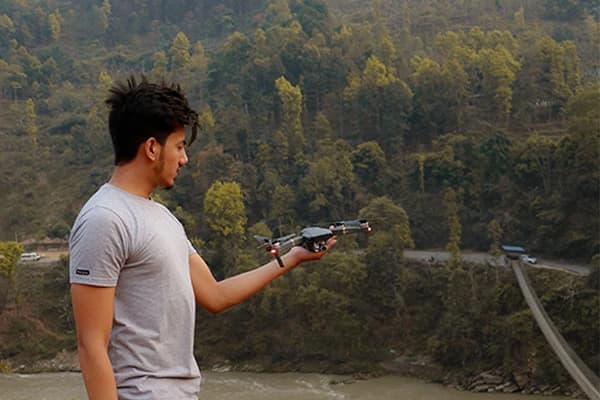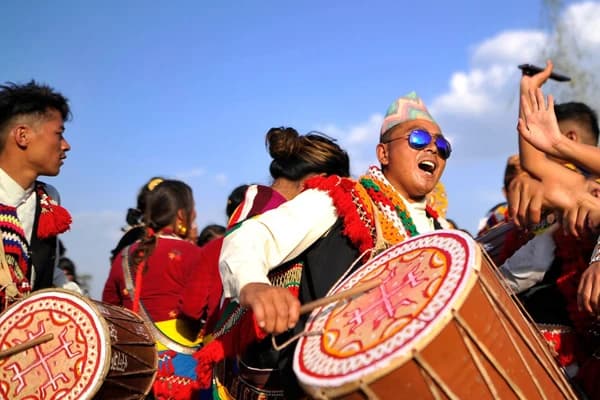The Enigmatic Land of Contrasts
- Geographical diversity: From the majestic Himalayas to the lush Terai plains
One of the main reasons for the popularity of Nepal among foreign tourists and nations is because of its diverse geographical landscapes. The country has a wide range of altitudes, climates, and ecosystems.
You can experience six different climate zones in the nation. The climate zones can be divided into tropical, sub-tropical, temperate, sub-alpine, alpine, and naval. The popular climatic zones are tropical, subtropical, and temperate zones, where you can see the majority of the human settlements.
Apart from the climatic zones, you can also enjoy the environments of the three major regions in Nepal: The Himalayan region, the mid-hill region, and the Terai region. Thousands of tourists came to trek to the Himalayan region. The reason behind the popularity of the Himalayan region for outdoor adventure is the beautiful snow-capped peaks and stunning vegetation.
In addition, the mid-hill is the area that covers the majority of the landmass of the country. This region is also the habitat of the majority of the population of the nation. The nepal capital, Kathmandu, is also in the Mid Hill region of Bagmati Pradesh.
At last, the Terai is the plain region of Nepal. This region is popular as the birthplace of Gautam Buddha; Lumbini lies in it. Moreover, you can visit Chitwan National Park, which also lies in this region.
- Climate variations and their impact on the landscape
As we discussed, Nepal has diverse climatic zones and conditions. It can have an impact on the various parts of the environment and tourism sector. common climatic impacts like forest fires, glacier melting, and desertification. These hazards can have a serious impact on the tourism industry of Nepal.
Moreover, global warming is also a serious concern, as it is affecting small nations like Nepal. The snow on the peaks is melting in huge amounts compared to previous times. The high climate changes are causing shifts in ecosystems, bird species mitigation, and changes in landscape processes.
Other impacts, like changes in rainfall patterns and the early leafing of trees and plants, have also been seen in recent days in Nepal. These changes have an impact on human well-being, water availability, carbon storage, food supply, and the tourism industry.
- Biodiversity hotspots: Nepal's rich flora and fauna
Nepal is home to diverse natural flora and fauna, despite its small region. About 7,000 species of animals and thousands of plant species can be found in the forests of the country. Some of the unique mammal species are rhinos, snow leopards, river dolphins, tigers, crocodiles, and pangolins. Moreover, Nepal is also home to endangered species.
One of the examples of biodiversity richness is Chitwan National Park. You can find varieties of plant and animal species that are rare and endangered. The other important protected areas that are biodiversity hotspots in Nepal are Sagarmatha National Park, Langtang National Park, and Rara National Park.
Cultural Mosaic: Nepal's Heritage
- Nepal's multicultural society
Nepal is a country where several ethnic groups reside and multiple languages are spoken. Around 123 different languages are spoken and over 100 ethnic groups reside in the country.
The major ethnic groups you can find in Nepal are Chhetri, Brahmin, Magar, Tharu, Tamang, Newar, Kami, and Yadav. Moreover, you can see the people in Nepal speaking languages like Nepali, Newari, Maithili, Tamang, Magar, and so on.
In addition, you can find people following multiple religious beliefs. The dominant religion is Hinduism, with 81% of Nepalese people following the religion. Similarly, the other religions are Buddhism, Islam, Kirat, and so on.
Nepal is also known for its diversity in music, dance, art, craft, folklore, languages, literature, philosophy, and festivals. Dashain is one of the good examples of the festival that is celebrated across the country.
- Iconic landmarks: Kathmandu Valley's UNESCO World Heritage Sites
While visiting Nepal, you shouldn't miss the Iconic landmarks in the capital city of the nation. Here, in Kathmandu, you can find several unesco world heritage sites that are rich in cultural and historical aspects.
Some of the important landmarks are Bouddhanath Stupa, Pashupatinath Temple, Kathmandu Durbar Square, Swayambhunath Stupa, Bhaktapur Durbar Square, Changu Narayan Temple and so on. These landmarks are the perfect examples of Nepal’s architectural and religious heritage.
Adventures in the Himalayas
- Trekking: An overview of popular trekking routes like Everest Base Camp and Annapurna Circuit
Trekking is an outdoor adventure activity popular in countries like Nepal, where you can find diverse landscapes and vegetation. Some of the most popular trekking routes are everest base camp trek and Annapurna Circuit with tilicho lake trrek, where you can enjoy the diverse landscapes and natural vegetation in between the Nepal Himalaya.
The Everest base camp trek is the trek to the gateway of the world’s tallest mountain, Mount Everest. You can enjoy the natural beauty and cultural immersion along the journey.
Moreover, the annapurna base camp trek is popular due to the multiple mountain ranges. Along the way, you can find green forests and traditional villages where you can learn about the rich tapestry of Nepal.
In addition, you can enjoy the warm hospitality of the Sherpas and Gurungs at the famous tea houses. By these treks, you can connect to nature away from the hustling and bustling life of the city.
- Mountaineering: Conquering the world's highest peak, Mount Everest
Mountaineering is a good way to challenge your inner strength and go for climbing the snowy peaks outside of your comfort zone. While conquering the world’s highest peak is not a joke,. Several people attempted and failed. But you can try to show your daring in between the Himalayan region.
Mount Everest has a height of 8,848.86 meters above sea level. This mountain is one of the most dangerous places in the world due to its high altitude, unpredictable weather conditions, and difficult terrain.
While summiting the peak, climbers face various problems like altitude sickness, harsh winds, avalanches, Khumbu icefall, and so on along the way. Despite the challenges and problems, thousands of people come to the summit or visit the Everest peak every year.
- Other outdoor activities: Rafting, paragliding, and jungle safaris
While visiting Nepal, there are various outdoor activities that you can give a try. Some of the popular outdoor activities include rafting, paragliding, and jungle safaris. You can experience Nepal’s beauty and unique culture through these activities.
a. Rafting: Rafting is a popular outdoor sport that is done in the rivers of the country. You can enjoy the thrilling experiences in the rivers along with other rafting mates.
Some of the popular rafting spots in Nepal are the Trishuli River, the Koshi River, and so on. The Trishuli River is suitable for beginners, while the Sun Koshi River demands experience and preparation.
b. Paragliding: Paragliding is another sport that you can do in Nepal, enjoying the clear skies and vistas of the Himalayas. You can do this sport in Pokhara city.
The glider’s takeoff point is Sarangkot and the landing site is at Lakeside, Khahare. There is the guide, or pilot, who flies along with you. The pilot controls the speed of the glider, the place of landing, and the overall activity of the glider.
c. Jungle Safaris: Jungle Safari is one of the outdoor activities that doesn't involve the thrill and adventure of trekking in the Himalayan region. But you will get to experience the country’s rich wildlife and natural beauty.
Some of the popular spots where you can enjoy jungle safaris are in the national parks of Chitwan and Bardia. During the safaris, you can see the rhinoceroses, tigers, and monkeys walking freely around the jungle, preying and living their life.
You will also get to see the diverse green vegetation and trees along your journey. The activities during the safaris include guided tours on the elephant backs. This activity is an excellent way to experience the mix of adventure, nature, and culture of the country.
Festivals and Traditions
- Dashain and Tihar festivals
In Nepal, several festivals are celebrated. However, the two main festivals that the majority of Nepalese people observe are Dashain and Tihar.
a. Dashain: It is the longest and biggest festival of Hindus. This festival is celebrated due to the victory of good over evil. The festival starts with the rituals of sowing the sacred barley seeds and ends with the rituals of receiving tika and blessings from the elders of the family.
This festival is also special because, during this festival, family members from different parts of the country and world come together in one house to celebrate. They exchange gifts and blessings and perform various religious rituals.
One of the popular rituals that is performed during Dashain is animal sacrifices. Animals are sacrificed and taken as a goddess's gift.
b. Tihar: Tihar is the second-biggest festival that is celebrated in Nepal. During this festival, different deities and animals are worshipped. These deities and animals are believed to be associated with the god of death, Yama.
During the Tihar festival, you can see the decorated houses with lights and rangolis. Nepalese people exchange gifts, sing, and dance during the festival. This festival is also called the Festival of Light or the Festival of Brothers and sisters.
The people of the Himalayan countries of Nepal, India, Bhutan, and Tibet celebrate Losar as a festival. This festival is the new year for the Tibetan people and is celebrated with great joy and excitement.
This festival is like the Dashain festival of Hindus. During this festival, family members from different parts of the country unite to celebrate the festival. If you visit Nepal during this festival, you can see people of the Himalayan region performing various rituals like burning pine resin, decorating homes with colored grains and wheat, offering prayers, and so on.
- Cultural significance and rituals associated with festivals
Every festival and ritual has cultural importance in Nepalese society. These festivals are the period for the Nepalese people to unite, celebrate the moment, and forget the hustling and bustling life for a time.
Furthermore, festivals are associated with various rituals and customs. The rituals and customs teach us about self-discipline and self-control and help in personal transformation. Rituals like mantras chanting and prayers help one find inner peace and connect to their spiritual selves.
Festivals and rituals are a great way to connect with the cultural heritage and traditions followed by the ancestors for a long time. Festivals are the events when you will forget all your material possessions and focus on enriching your emotional wealth.
Nepalese Cuisine: A Gastronomic Journey
- Staple foods: Dal, bhat & Tarkari
The popular Nepalese cuisines that are consumed all over the nation are Dal, Bhat, and Tarkari. This dish is traditional and widely popular among Nepalese people. Dal is the cooked lentil soup or pulses, that is, steamed rice, tarkari means seasonal vegetable curries, and achaar means pickles.
- Regional specialties: Newari cuisine, Thakali food, and Sherpa delicacies
In Nepal, some diverse traditions and cultures consume a variety of dishes. Some of the popular and loved cuisines by foreigners are Newari, Thakali, and Sherpa cuisines.
a. Newari Cuisine: This cuisine originated from the Newari people of the Kathmandu Valley. The Newari dishes that are popular are Yomari (sweet rice cakes), Samaya Baji (platter of beaten rice, buffalo meat, pickles, and chutneys), and Bara (crispy lentil fritters). These are the most popular and loved dishes among Nepalese and foreigners.
b. Thakali Cuisine: The Thakali dishes are another popular Nepalese cuisine that you can enjoy upon visiting Nepal. Both locals and tourists enjoy eating dishes like sukuti (dried meat curry) and yak stew in the Himalayan region.
c. Sherpa Cuisine: The Sherpa cuisine is produced and consumed by the Sherpa people and tourists. Some of the dishes are Thukpa (Tibetan-style noodle soup) and Tsampa (roasted barley flour), which are popular among tourists and sherpas.
- Street food culture and must-try dishes
When you visit Nepal, don’t forget to try out the delicious street foods. The street food culture started a long time ago. This culture shows the country’s rich gastronomic heritage. Some of the must-try street foods are Momos, Chatamari, Sekuwa, Thukpa, Aloo Chop, and so on. You can find these food items in various places in Kathmandu and other places in Nepal.
Practical Travel Tips for Tourists
- Visa and entry requirements
While traveling across the nation, a visa is required, and so is for Nepal. When traveling to Nepal, you can get various types of visas like tourist, business, and student visas. The on-arrival visa can be obtained at the Tribhuvan International Airport for most nationalities. For those who are eligible for the on-arrival visas, you need a valid passport, passport-sized photos, and payment of the visa fee in USD.
In terms of the visa fees and durations, you have options like 15, 30, or 90-day visas, with a visa extension facility available when needed. In addition, additional permits are required if you are traveling in risky high-altitude areas or trekking in remote areas.
The best time to visit Nepal is during the spring and autumn seasons. These seasons are best known for their mild temperatures, clear skies, and pleasant weather. Moreover, you can go on the Everest Base Camp trek and Annapurna Circuit trek during these seasons.
The temperatures during these seasons range from 17 to 23 degrees Celsius. These conditions are perfect for outdoor activities like rafting, paragliding, and jungle safaris. Most foreign tourists choose autumn because it is the best time.
During the autumn season, Nepalese popular festivals Dashain and Tihar are celebrated. So, you can get a chance to be part of the Nepalese culture and traditions.
- Health and safety tips for travelers
- Consult with a healthcare professional before going trekking in high-altitude areas.
- Drink bottled or purified water to prevent waterborne diseases
- Maintain hygiene by washing hands or using hand sanitizer
- Carry a basic first aid kit with important medications, bandages, and other medical supplies
- Respect local customs by removing shoes before entering temples and using the right hand for giving or taking
- Stay hydrated while going trekking in high-altitude areas
- Choose the restaurants that prioritize hygiene and food safety
- Save the emergency contact numbers, like the contact numbers of the embassy, local emergency services, accommodation details, and other emergency helplines.





